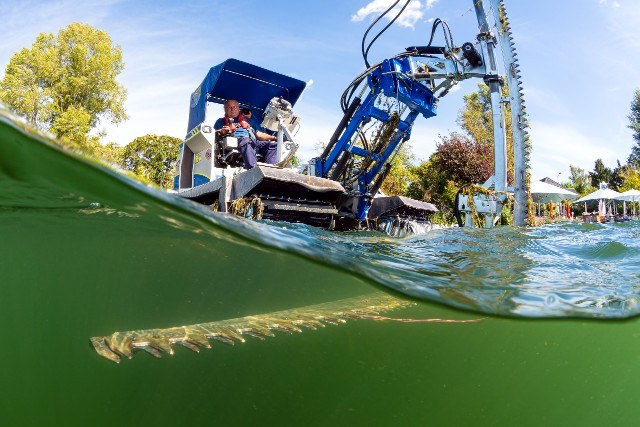Mowing of aquatic vegetation in the Alte Donau
Since 2003, mowing boats have been in operation to ensure that people's enjoyment of swimming in the Alte Donau is not marred by tall underwater plants.
Despite its high ecological value, submerged aquatic vegetation is unpopular with swimmers and boat owners. This is especially true of high-growing species like the spiked water-milfoil, currently the dominant underwater plant in the Alte Donau. These plants grow up to the surface of the lake, where they easily get tangled in the propellers of boat motors, impede rowers and brush against the limbs and abdomens of swimmers.
Underwater plants in the Alte Donau
Management of aquatic vegetation

To address the issue, the City of Vienna developed a maintenance and management plan for the submerged aquatic vegetation in the early 2000s. The scheme provides for targeted mowing to keep the underwater plants under control, the aim being to remove hindrances to swimming and boating while avoiding any harm to the plant populations. A managed mowing schedule ensures that the mowing of the underwater plants does not disrupt the ecological balance of the lake.
The mowing regime is also expedient from the ecological point of view: the plant clippings are removed from the water, which reduces the overall amount of nutrients in the ecosystem and thus prevents eutrophication. Furthermore, pruning of the submerged vegetation improves the conditions for growth of low-growing species such as stoneworts (charophytes).
Huge proliferation of underwater plants
A drastic increase in underwater plant growth in recent years poses a major challenge for the City of Vienna's mowing management scheme. The mowing boats only used to be in operation for a few months during the season, but since 2014 mowing has been necessary virtually all year round. In response to this trend, the City of Vienna's team of experts have initiated a series of additional measures. Alongside the mowing schedule, these include targeted planting of low-growing aquatic plant species.
New amphibious mowing boats
New mowing boats were introduced in 2018 to improve the effectiveness of the mowing operation. The smaller, highly efficient amphibious craft can mow to a depth of 2.5 metres. They are faster than their predecessors and can also reach areas where access is difficult.
The new mowing boats are used for the mowing process itself as well as for gathering up the clippings. They are accompanied by motor boats which transport the clippings to the designated collection points around the lakeshore. From there they are taken to the Lobau Composting Plant and processed into Guter Grund organic compost, which is available to the public at waste collection and recycling centres throughout Vienna.
Thanks to their caterpillar tracks, the amphibious mowing boats can also travel on land. Once the day's mowing schedule is completed they leave the water and are driven to their lakeside base for servicing.
Deep mowing: a new measure
Back in 2017 the municipal administration piloted deep mowing operations in which the underwater plants are cut short enough to delay rapid regrowth. The aquatic vegetation is cut off at a depth of approx. 2.5 metres, i.e. just above the lakebed. Deep mowing allows a break between the several rounds of mowing operations required in the course of a season.
Since 2017 it has been carried out each spring before the start of regular mowing operations.
Scientific monitoring
In order to control the development of the submerged vegetation, regular checks are carried out under scientific supervision.
The growth of the underwater macrophytes is monitored by aquatic biologists at regular intervals throughout the summer months. Among other activities, the scientists dive with echosounders to localise the underwater plants using sound waves. Precise digital mowing plans can then be produced on the basis of these collected data.
The production of the GPS-based digital mowing plans and the installation of the necessary technological apparatus aboard the mowing boats were measures implemented as part of the EU LIFE+ Alte Donau project.
The mowing boats are equipped with GPS, computers and the corresponding special software. Using GPS in combination with the digital bathymetric chart of the Alte Donau allows precise determination of the required mowing depth.
Unmown refuge zones
Over the past few years, a number of refuge zones have been created in little-used stretches of water close to the lakeshore in which the underwater plants are left unmown.
The underwater plant population plays a vital role in maintaining the water quality, but is sensitive to disruption. It is therefore important to keep some areas unmown to compensate for the intensive mowing elsewhere. These unmown zones also serve as undisturbed spawning grounds and refuges for fish.
The unmown zones are being extended in 2018. New refuge zones are planned on the lower section of the Alte Donau north and south of Gänsehäufel island, on the middle section of the Kaiserwasser arm and on the upper section of the Alte Donau east of Birnersteig.

The LIFE+ Alte Donau project was funded under the LIFE+ Programme of the European Union as part of the "Environment Policy and Governance" strand.
City of Vienna | Water Management
Any questions, requests, or concerns? Please contact the City Service at contact form
